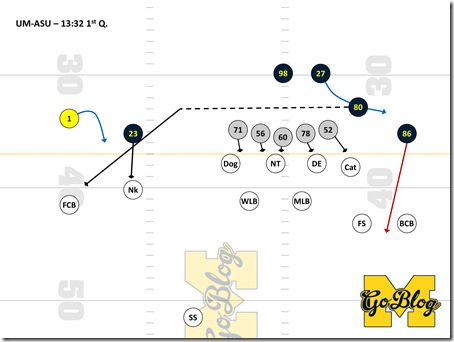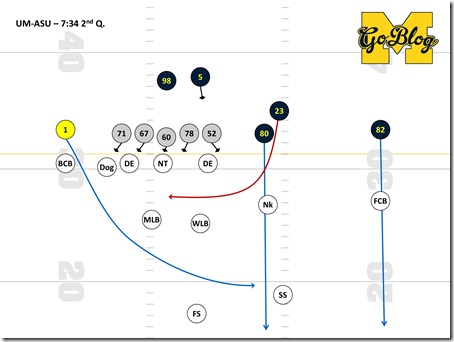Videos now working.
Megatron—the Decepticon, not the Detroit Lion—is definitely the most interesting robot in the Transformer pantheon. Classic Megatron had the most clearly defined mission—pillage Earth's energy resources to power Cybertron—of any imaginary bad guy leader, but still possessed all the classic bad guy traits: narcissism, obsession with power, mistrust.
That last gave the character a rich irony, since in order to provide his greatest contribution in a fight, Megatron had to transform into a weapon wielded by someone else—usually that was Starscream, Megatron's primary rival for power. Nobody seemed to mind the physics of a transformer equal in size to Optimus Prime—a truck cab—transforming into a handheld blaster.
The thing Carr said when he gave Braylon the number is it's going to make you a target—the defense will always be accounting for #1. But there's no point in having such a powerful bad guy if you don't give him plenty of his own screen time. Somehow, Nussmeier managed to get Funchess open all over the field this week, and I wanted to know how.
Catch 1: Quick WR Screen
How to read these diagrams: Black lines are blocks, blue are routes, red denotes the hot read (as best as I could tell) and dotted lines are pre-snap motion. Click for bigger.
Michigan has just spent an offseason talking about how they're going to be an inside zone team. So Nussmeier chooses the best possible debut: a totally spread "quick screen" to the guy in #1, with an extra block courtesy of putting the U-back, Khalid Hill, in motion. Hill goes flat to kick out whoever appears, Norfleet starts downfield then latches on to the guy over him creating space for Funchess to get the ball and turn downfield.
Why it worked: Like Megatron, Funchess may be big but he's also got the acceleration and wiggle of a much smaller guy, and the screen gets those qualities in space against small defensive backs. Because he's a such a downfield threat the defense has to give him that space at the snap (even MSU did that last year). To stop this the defense needed to react super-fast and/or beat a block.
Such a quick pass also saved the OL from having to make long or difficult blocks, so there was no need to have a perfect protection scheme—the backside routes were both outlets in case the CB on Funchess was jumping the route or something.
How it helps the offense: This play punishes App State's space linebacker (#88 in the videos, denoted as WLB in the diagrams for simplicity's sake) for coming down into the box, something opponents did a ton of to us last year. That guy is responsible for the edge if the offense is running to his side, so forcing him to book it outside on the first play really messes with how that guy can react to things the rest of the day.
Downsides? This is highly coordinated play that had to have taken a lot of practice time to execute. That practice time was only worth it because it directly punishes the defense for playing sound against the rest of the offense.
[The other seven, after the jump]
Catch 2: Double Move for TD
On 3rd and 7 they lined up Funchess in the slot and split the TE (Hill) out wide; App State allowed the TE/CB matchup, leaving Funchess on that poor linebacker, who at least has help over the top.
Why it worked: Ninja route.
ASU's defensive call was fine—the safety had to pick between Funchess and Chesson and came down on the correct guy, but Funchess's footwork and the situation (Michigan can get a 1st down at the two yard line) get both guys in coverage to bite on a perfectly executed double-move. One cut later…
How it helps the offense: Third and long scenarios are separate from the flow of the offense, but it's nice to show the defense early on that we can take their top off at any moment.
Downsides: Gutsy call; with decent coverage Michigan's kicking a field goal.
Catch 3: Lost on the Sideline
Again the TE was in motion. This is a PA rollout that Brian hates because it puts Gardner's back to the defense, and sure enough there's a DE (3-4 OLB, same thing) coming up to force a back-foot throw. The nickel checks Chesson and sits down in a flat zone while the cornerback over Funchess gets left with two dudes going deep. Funchess cuts off his route by the sideline.
Why it worked: Either the nickelback messed up a quarters read or, more likely, he just got triangle'd; the safety reacting to play-action doesn't seem to be worried about the field corner guarding two dudes, so either the PA made him come off Chesson (and the CB had to stay with the deeper route) or Funchess just found the hole on the edge of the nickel's zone.
How it helps the offense: Play-action on outside zone is scissors in this offense. OZ is a base complement to the base of inside zone, and showing it then passing behind it will keep those LBs and safeties from activating too quickly against it. A rollout is how you punish teams who try to react quickly to under-center running, which by nature attacks very quickly and downhill.
Downsides? Down with waggles. In order to run under center you need to show you can play-action from it, but you can run IZ and OZ just fine from the shotgun or pistol. [UPDATE: there's discussion on this in the comments. With a running QB teams won't usually be coming hard upfield because they can't risk breaking contain; the EMLOS will be watching the outside most often, not trying to scream inside as much.
Catch 4: Pick'd
This is play-action from the draw they ran earlier with a fullback as lead blocker and the LBs bite hard when they read Kerridge coming down the B gap and Green behind; both of those guys swing out for a checkdown pass while Chesson and Hill are going downfield to draw the safeties back.
This was all to get the intermediate route open. Funchess uses his speed to run off his coverage, and the deep routes of the other two guys create a bunch of bodies for that dude to work through. By the time Gardner's stepped up in the pocket Funchess has crossed the formation and is open 20 yards downfield. Bad mechanics by Gardner almost airmail it but Funchess brings it down on a short hop, stiff-arms a helpless cornerback, and scores.
Why it worked: ASU by this point knew Michigan really wanted to get some power running going, and that got the linebackers out of intermediate zones and out of Gardner's hair. When you get protection that can last that long, and there's a guy with Funchess speed coming across the formation, that's going to come open.
How it helps the offense: Again, the offense has to respect play-action from Michigan's base run look.
Downsides? This OL versus long-developing routes. The checkdowns to the RBs aren't likely to get much.
Catch 5: Unbalanced
At this point Michigan has been showing various run looks (IZ and power) from a similar formation. This time there's a wrinkle: it's an unbalanced line. M lines up with 10 seconds on the clock and ASU does a last-second changeup when they realize this—they're still expecting a run to Braden's side, and I'm guessing Gardner has been taught to throw the quick-hitter to Funchess if it's open. Easy yards taken.
Why it worked: Again again this is showing the defense a "we're running" look and punishing them for adjustments to the run. The ASU middle linebacker was stepping up to get a TFL on a backside cut and that created enough space for Michigan to get the ball to Funchess. Now it's Funchess in space versus defensive backs.
How it helps the offense: Michigan's best runs (including the long Green one) came from a similar (balanced) formation. This play forces the defense to play that honest.
Downsides? Unbalanced means one less receiver the defense has to worry about; when that receiver is A.J. Williams you're not giving up much.
(Non-)Catch 6: Back to the Well
Having Funchess work across the offense worked so well last time let's try it again. Darboh and Hill run off the coverage and Funchess leaves linebackers in his dust as he comes across the middle; Gardner threw behind him. Norfleet was running an underneath route to serve as either outlet or a way to keep the LBs from getting depth on Funchess's route.
Why it (should have) worked: Funchess can run guys off if the protection can last.
How it helps the offense: Attacking deep LB zones is the meanest thing you can do to linebackers charged with stopping runs.
Downsides? A lot of time and a lot of guys to work through before it comes open.
Catch 7: Bubble Screen
Remember the look from Catch 5 above? This is a very similar thing to that, and serves the same purpose: use Funchess as a quick-hitting option to the wide side so the defense can't overreact to the short side running game.
Why it worked: Well blocked by Chesson and Norfleet—the SS is the guy who had to make the tackle, and by that point it's easy yards.
How it helps the offense: Same as 5: keeps the defense from being too aggressive against the base run.
Downsides? Bubble screens aren't manly.
Catch 8: LOLOLOLOLOLOLOLOLOL
This was just mean.
Why it worked: Funchess can leap out of the building; ASU defensive backs: not so much.
How it helps the offense: Oh by the way, there's a third dimension you now have to cover.
Downsides? Requires an otherworldly being.
Conclusions
All of this was Michigan operating in an offense that made sense. Funchess was deployed in ways to put huge pressure on the defense: Overreact to the run and he'll get open in space; try to cover him over the top and he'll find the soft part of your zone; try to prevent him from getting the first down and he may put a move on your guys for six. And when we get down near the end zone, you'd better keep your safeties back and hope they brought their pogo sticks.
The spread forces defenses to cover the width and depth of the field and the offense Michigan used against Appalachian State was very conceptually spread, with a bonus dimension (up and down) you have to cover because Funchess isn't limited to merely one plane.


























